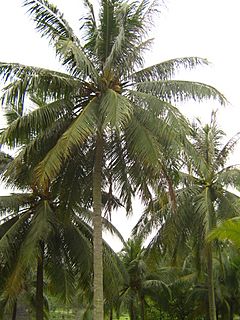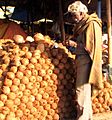Coconut palm facts for kids
Quick facts for kids Coconut |
|
|---|---|
 |
|
| Coconut palm (Cocos nucifera) | |
| Scientific classification | |
| Kingdom: | |
| Division: | |
| Class: | |
| Order: | |
| Family: | |
| Genus: |
Cocos
|
| Binomial name | |
| Cocos nucifera |
|
The coconut palm is a tall palm tree that belongs to the Arecaceae family. These amazing trees can grow up to 30 meters (about 100 feet) high! Their long leaves can be 4–6 meters (13–20 feet) long. When we talk about a "coconut," we usually mean the fruit that grows on this palm.
Coconut palms are found in many warm, tropical countries around the world. They especially love growing along the coasts, like in India and Bangladesh. The coconut fruit has a hard shell, but inside it holds delicious white flesh and refreshing coconut water.
Contents
What Are Coconuts Used For?
Coconuts are super useful! People use them in many different ways.
Food and Drink
The white flesh inside a coconut can be eaten raw. It's also used in lots of cooking to add a special flavor. Coconut milk is made from the grated flesh and is a popular ingredient in many dishes and drinks. You might find it in curries or smoothies!
Coconut oil is another important product. It's used in cooking, but also in things like soaps. The clear liquid inside a young coconut is called coconut water. It's a natural, refreshing drink that's very popular in tropical places.
Crafts and Culture
The hard shell of a coconut can be used to make beautiful crafts. Artists carve them into bowls, decorations, or even buttons.
In some countries, coconuts have special meanings. For example, in Sri Lanka, people use coconut flowers for wedding celebrations. The coconut palm is also the National tree of the Maldives.
How Coconuts Travel
Coconuts are amazing travelers! They can float on water for a very long time. This allows them to drift across oceans to new islands.

Scientists have found that coconuts can float for up to 110 days. That's enough time to travel about 3,000 miles (4,800 kilometers) by sea! Even after such a long journey, they can still sprout and grow into a new tree when they land on a sandy beach. This is how coconut palms have spread to so many tropical islands around the world.
Images for kids
-
Fossil "Cocos" zeylanica from the Miocene of New Zealand, approximately the size of a strawberry at 3.5 cm (1+1⁄2 in) long
-
Chronological dispersal of Austronesian peoples across the Indo-Pacific
-
A wa'a kaulua (double-hulled canoe) from Hawai'i. Catamarans were one of the early technological innovations of Austronesian peoples that allowed them to colonize the islands of the Indo-Pacific and introduce coconuts and other canoe plants along their migration routes.
-
Palms tolerate the saline and infertile soils of laterite type in Goa, India
-
Coconut trees on a beach in Upolu, Samoa
-
Coconut germinating on Punaluʻu Beach on the island of Hawaiʻi
-
The Pacific flying fox (Pteropus tonganus) feeding on nectar and pollen from coconut flowers in Fiji
-
Red nata de coco in syrup from the Philippines
-
Macapuno preserves sold in the United States
-
Coconut trees line the beaches and corniches of Oman
-
Immature green coconuts sold in Bangladesh for coconut water and their soft jelly-like flesh
-
Coconut milk, a widely used ingredient in the cuisines of regions where coconuts are native
-
Coconut water drink
-
Ubod (coconut heart of palm) from the Philippines
-
Bahalina, a traditional coconut wine (tubâ) from the Philippines fermented from coconut sap and mangrove bark extracts
-
Coconut buttons in Dongjiao Town, Hainan, China
-
Extracting coir, the fiber from the coconut husk, in Sri Lanka
-
Pusô, woven pouches of rice in various designs from the Philippines
-
Palaspas, woven palm fronds during Palm Sunday celebrations in the Philippines
-
A "coconut monkey" from Mexico, a common souvenir carved from coconut shells
See also
 In Spanish: Palma cocotera para niños
In Spanish: Palma cocotera para niños
































